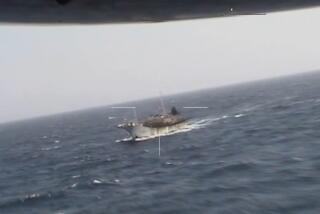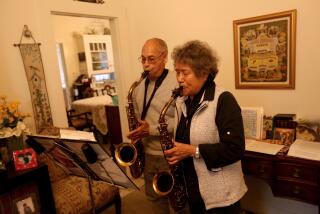Son Follows the Old Man and the Sea
SAN PEDRO — For the leathery-skinned, gravel-voiced fisherman and his son, it is a daily ritual.
Before dawn, they leave Los Angeles Harbor at San Pedro to go fishing for halibut aboard the Ave Maria, their rusting, 33-foot, gill-net fishing boat. The son, 25, a stocky former cowboy, was born in San Pedro but grew up in Montana after his parents divorced.
The old man, who says he started fishing “when I was still in my diapers,” never left the sea.
Now, the young man is back on the waterfront, learning to become a fisherman as did his father and grandfathers before him.
‘Takes Years to Learn’
“I’m trying to teach him everything I know. It takes years to learn how to become a fisherman,” said Andy Kuglis, 74, the other day as he wrested a 20-pound halibut from the green monofilament net.
Pelicans and gulls soared gracefully over the half-century-old fishing boat. Yellow floats dangled from the side as the Ave Maria bobbed like a cork, two miles off Huntington Beach. The fishing boat’s spool creaked as it cranked in a 240-foot-long series of attached nets entangled with halibut, mackerel, shovel-nose sharks, crabs, starfish and kelp.
“All my life I dreamed of coming back to San Pedro to become a fisherman like my father,” mused Gregory Kuglis as he and his dad pulled fish from the net and tossed them into large plastic buckets on deck.
“Dad knows all the places where the fish hang out. He’s uncanny. He knows how to find them, how to catch them. He has been fishing steady for 62 years. Ask any old-time San Pedro fisherman about Andy Kuglis. They’ll tell you he’s one of the best.”
Only Two Canneries Left
Years ago, sons of local fishermen followed their fathers’ footsteps as naturally as the change in seasons. Not today. Fishing off Southern California is not what it used to be. Twenty years ago there were a dozen canneries in San Pedro; today there are only two.
“Most sons of fishermen now work on the beach in a variety of other jobs,” explained Ivo Zorotovich, 76, a longtime fisherman. “The opportunities for making a decent living fishing in local waters are limited.”
The fish are still here, said Tony Vidovich, 60, another veteran, “but not the money.”
The bulk of commercial fishing is done on large boats operated by foreign crews in distant waters and the catch is processed in canneries in places like Samoa and Puerto Rico where wages are much lower, noted John Gligo, 62, who has spent his life in the fishing industry.
But Greg Kuglis is not to be deterred. “It’s something in my blood. I know I’m going to make a go of it,” he insists.
Began in Yugoslavia
Andy Kuglis’ father, grandfather and many grandfathers before him were fishermen on a Santa Catalina-size island called Komiza off Yugoslavia. His father came to this country in 1900 at the age of 17.
“We lived in Astoria, Ore., until I was 8 years old in 1920, when we came to San Pedro,” recalled the elder Kuglis. “Four years later I started fishing full-time with my father. I’ve been fishing ever since. There were four of us Kuglis boys. We all fished with my dad.”
His father and an uncle both died at sea. His father had a heart attack fishing off Santa Barbara Island. His uncle was washed overboard from a fishing boat and drowned. “I knew a lot of guys who lost their lives fishing,” he said.
“It’s a tough life. In the old days we pulled nets from the bottom by hand. We’d get through pulling nets in the afternoon and each arm was six inches longer. We did everything by hand. There were no machines. We made our own nets by hand. Now your grandmother can fish.”
Still a Lot of Work
But his son disagreed.
“Come on, dad. It’s still a hell of a lot of work. You can’t deny that.”
As he spoke, a fish gill cut a deep gouge in his arm and blood squirted all over his shirt sleeve.
“The work never ends,” he said. “When we’re not fishing, we’re cleaning fish, hanging nets, stripping rope, molding lead to cast weights. It can be dangerous. You can be washed overboard, get caught in the gill-net spool, which can crush you like a hotcake and kill you.”
The gill net, the elder Kuglis explained, has been used since Biblical times. Anchored and weighted on the bottom, it stands straight up for the fish to swim into. “Jesus and Paul fished the Sea of Galilee with the same kind of net,” Kuglis said.
Over the years the older man has owned or been part owner of a dozen fishing boats--the Sunny Boy, Miss California, New Victoria, California Bear, Vinmar and The Bear, to name a few. He has fished mostly halibut, from Mexico to Canada, as well as salmon in Alaska, and spent two years in South America teaching Chileans how to fish.
“Fishing always provided me with a good living,” he reminisced. “During the Great Depression, when a lot of guys were flat broke, I always had money. I was making $25 a day then, more than a lot of them were making a week. That was when a dollar was a dollar.”
Sail at 4
Today he and his son, often joined by a deck hand, will go out at 4 in the morning, fish most of the day and be back dockside in San Pedro by 4 in the afternoon.
“On good days we will bring in 300 to 400 pounds of halibut. Other days, we don’t catch much; some days nothing,” Kuglis said. The fishermen are paid about $2.20 a pound by fish markets for halibut that retails in stores for $7 to $8.50 a pound.
This was a slow day. Kuglis and his son earned a little less than $200 for their catch.
As they were resetting their nets before sailing home, Andy Kuglis cautioned his son: “Not too much slack. Not too taut or the fish will bounce off the net. . . . “
It was another day of learning for the young fisherman returning to his roots.
More to Read
Sign up for Essential California
The most important California stories and recommendations in your inbox every morning.
You may occasionally receive promotional content from the Los Angeles Times.










